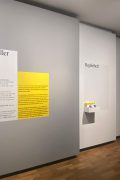Since the end of the 19th century, Munich has been an important centre of goldsmithing and jewellery. The Münchner Stadtmuseum has acquired a collection of Munich jewellery that bears testament to this history. To mark this occasion, an exhibition was planned which put these pieces in dialogue with the contemporary works by students of the Schmuckklasse of the Academy of Fine Arts in Munich. The design of the exhibition focused on providing an unbiased framework for this juxtaposition. A limited set of interventions were implemented to condense and clear up the existing space. Unsurprisingly for a jewellery show, the basic element of the exhibition design was the vitrine (all of the pieces had to be kept behind glass). These showcases take a variety of distinctly different forms, which both structure the space and provide a framework for the exhibited pieces.


At the centre of the exhibition stands a facade-like – 27m x 2,8m – vitrine. The pieces are hung on the wall, following a series of themes yet devoid of hierarchy, arranged in loose constellations rather than forced connections, more star chart than scientific taxonomy. Opposite the vitrine a – physical and formal – mirror image of the vitrine puts the visitors themselves – and thereby their bodies, the actual context for these pieces – into the scene. The central section is preceded by a wall and table-arrangement excerpted – albeit in less precious material – from Hans Hollein’s iconic Schullin I jewellery store. The polished showcase is challenged by a small vitrine, made of the same material but vividly painted, if not vandalised, by the artist of the piece exhibited therein. At the other end of the wall, the exhibition concludes with a section dedicated to the face in jewellery. Reminiscent of a portrait gallery, the pieces are arranged in a set of wall-hung frames. These spaces bracket an exhibition postscript made up of a rotunda of posters and a video room.

















